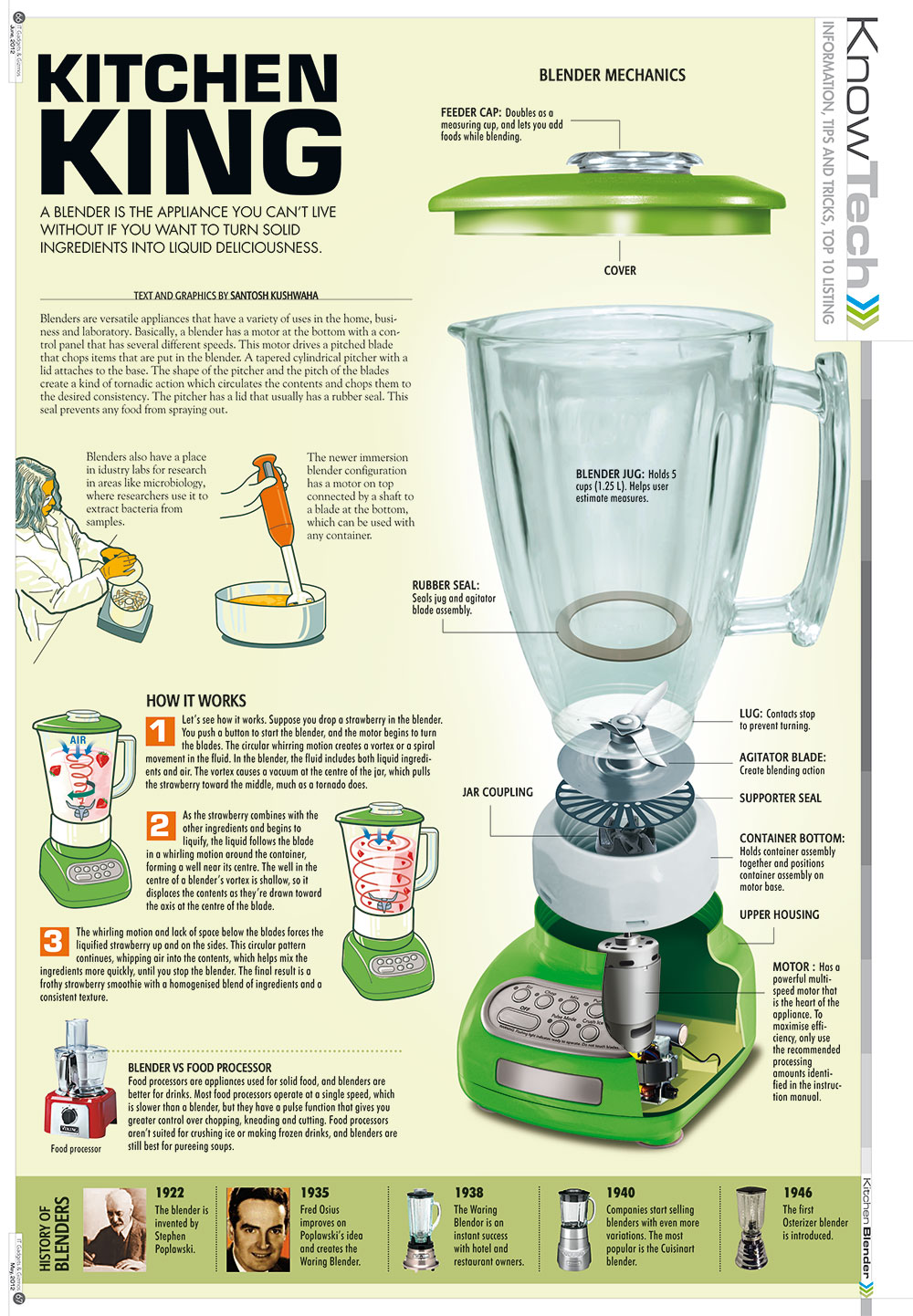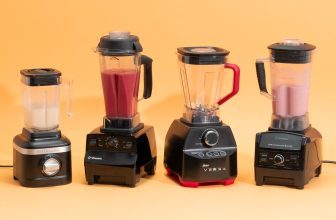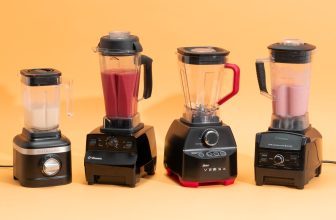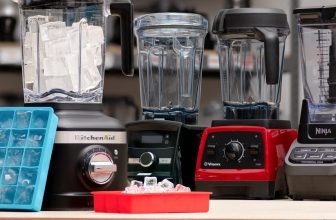As an Amazon Associate I earn from qualifying purchases.
How Blenders Work?
How Blenders Work? From revolutionizing kitchens to becoming an indispensable tool in households and restaurants, blenders have certainly earned their place. Have you ever thought about the sophisticated mechanisms that make this kitchen marvel operate so efficiently? It’s intriguing to see how a simple push of a button can turn solid ingredients into smooth concoctions in mere seconds.
At its core, a blender works through the interaction of a powerful motor and sharp blades, designed to create a vortex that pulls ingredients down. This mechanism has evolved since Stephen Poplawski invented the first blender in 1922. Modern blenders can reach speeds up to 30,000 RPM, a feat that underscores their incredible efficiency in food processing.

How Blenders Work
Blenders are essential kitchen devices designed to mix, purée, or emulsify food and other substances. At their core, blenders operate by using a powerful electric motor that drives a series of sharp blades at high speeds. The motor’s strength and the blades’ design create a vortex that pulls ingredients down towards the blades. This vortex ensures all ingredients are evenly mixed and finely blended. It’s fascinating how quickly and efficiently blenders can break down solid ingredients into smooth mixtures.
One of the first things to understand about blenders is their basic structure. Typically, a blender consists of a base which houses the motor, a removable jug, and a lid. The jug usually sits on the motor base, allowing the blades at the bottom to spin. Some modern blenders also include various speed and power settings to handle different types of foods and textures effectively. These settings range from a simple pulse to full-speed blending.
The speed and power settings on a blender are indispensable for achieving the desired consistency of the mixture. Lower speeds are perfect for soft fruits or making soups, while higher speeds handle tougher ingredients like ice or nuts. Some blenders come with pre-programmed settings for specific tasks like crushing ice or making smoothies. This functionality enhances their versatility, making them suitable for a wide range of blending needs. Transitioning between these settings ensures a seamless blending experience.
Blades in a blender are typically made of strong, stainless steel and come in various shapes. The shape and orientation of the blades significantly impact the blending results. Some blenders feature multi-level blades designed to create different results, such as chopping, grinding, or liquefying. Modern blenders have advanced safety features, including automatic shut-off if the jug is improperly positioned. These features highlight how technology continues to improve the functionality and safety of common kitchen tools.
The Basic Design and Mechanism of a Blender
The basic design of a blender is fairly simple yet effective. The main parts include the motor base, the jar or jug, the lid, and the blades. The motor base houses the blender’s powerful motor, which drives the blades. On top of the motor base sits the jug, usually made of glass, plastic, or stainless steel. The lid fits tightly to prevent spills during blending.
The motor in a blender is crucial for its operation. It connects to the blade assembly via a drive shaft. When you turn the blender on, the motor spins the blades at high speeds, creating a vortex. This vortex pulls ingredients down towards the blades, ensuring they are chopped, mixed, and emulsified evenly. The faster the blades spin, the finer the blend.
Blenders often come with several speed settings to handle different tasks. For example, a low setting might be used for mixing liquids, while a high setting can crush ice. Some blenders even have pre-programmed modes for specific jobs like making smoothies or purees. These settings offer versatility, making the blender suitable for various culinary tasks. Transitioning between these settings is usually seamless thanks to easy-to-use controls.
In terms of safety, modern blenders include several features. Many have locking mechanisms that prevent the motor from running unless the jug is properly attached. Some models also have thermal sensors that shut the motor off if it overheats. This prevents damage to the motor and ensures user safety. Safety features are essential to protect both the device and its users during operation.
The Role of the Motor in a Blender
The motor in a blender is essentially its powerhouse. It transforms electrical energy into mechanical energy, which spins the blades. The power of the motor determines how quickly and efficiently ingredients are blended. A strong motor can handle tough jobs like crushing ice or blending nuts. This efficiency ensures smooth textures in a shorter time.
The motor’s performance is measured in watts or horsepower. Higher wattage typically means more power and faster blending speeds. For instance, a blender with 600 watts is good for general use, but a professional-grade blender might have up to 1500 watts. This extra power allows for more versatile blending options. Besides, it can consistently handle heavy-duty tasks.
Another essential feature is the motor’s variable speed settings. These settings let you adjust the blending speed based on the task. For example, a low speed might be ideal for gentle mixing, while a high speed can pulverize ice. Many blenders also come with a pulse function for short bursts of high-speed blending. These features offer users more control and precision.
Blenders also incorporate motor protection features. Overheating sensors are common, shutting the motor off if it gets too hot. This prolongs the motor’s lifespan and ensures safe operation. Some models include cooling systems that keep the motor at an optimal temperature. These safety features highlight the importance of a well-designed motor in a blender.
The Significance of Blender Blades and Their Design
Blender blades are a crucial element in determining the device’s efficiency and versatility. Made typically of stainless steel, these blades are designed to be durable and resistant to rust. Their sharpness and shape directly impact the quality of the blend. For instance, a blade with multiple edges can chop ingredients more finely than a single-edged blade. The design ensures that all ingredients are evenly processed.
Various types of blender blades serve different purposes. Some common designs include straight, curved, and serrated blades. Curved blades help create a smoother blend, ideal for soups and smoothies. Serrated blades are excellent for crushing ice and handling tougher ingredients. Each blade type offers unique benefits that cater to different culinary needs.
- Straight Blades: Ideal for basic blending tasks
- Curved Blades: Provide smoother textures
- Serrated Blades: Effective for crushing ice
Blade assembly is also vital for a blender’s performance. Many blenders have blade assemblies that are detachable, making cleaning more manageable. Some models use a single, fixed blade design, while others utilize a multi-level blade system. Multi-level blades can create better blending cycles as they pull ingredients down more effectively. This design minimizes the need for stopping and stirring.
Modern blenders often include safety features related to blade operation. Automatic shut-off mechanisms prevent the blades from spinning if the lid isn’t securely in place. This ensures that the blades don’t operate when the blender is open, preventing accidents. Safety considerations are crucial in designing effective and user-friendly blades.
The material and build quality of blades are other important factors. Stainless steel is preferred because it is robust and maintains sharpness over time. High-quality blades reduce wear and tear, making the blender last longer. Investing in a blender with well-designed blades ensures smoother, consistent results and durability.
The Importance of Speed and Power Settings in Blenders
Speed and power settings in blenders are crucial for achieving the right consistency for various tasks. These settings allow you to adjust the blender’s performance based on the ingredients you’re working with. A low setting might be perfect for mixing liquids and softer items. Conversely, high-power settings are ideal for tougher tasks like crushing ice or blending hard vegetables. This versatility makes blenders useful for a range of kitchen activities.
Many blenders come with multiple speed options, typically controlled through a dial or buttons. These options range from gentle pulsing to intense blending. For example, a pulse setting can be useful for chopping ingredients without overdoing it. Higher speeds can create smooth textures preferred in smoothies and purees. The ability to change speeds during blending offers more control and precision.
- Low Setting: Ideal for mixing liquids
- Medium Setting: Suitable for soft foods
- High Setting: Best for tough ingredients
- Pulse Function: Offers controlled chopping
Power settings in blenders are usually measured in watts. A blender with higher wattage generally has more power, allowing it to handle tougher ingredients. For basic tasks, a 300-watt blender might be sufficient. However, for more demanding tasks, a blender with a power range of 700 to 1500 watts is preferable. More power translates to faster, more efficient blending.
Another significant aspect is the consistency and reliability of these settings. High-quality blenders offer seamless transitions between different speeds. They also maintain consistent power throughout the blending process. This consistency is vital for achieving the desired texture without constantly stopping to adjust settings.
Incorporating speed and power settings allows for greater flexibility in food preparation. For instance, blending a delicate sauce requires a different approach compared to making a thick smoothie. By utilizing these settings effectively, you can achieve optimal results for a variety of recipes. This adaptability makes blenders indispensable kitchen tools.
How Modern Technology has Improved Blenders
Modern technology has significantly improved the functionality and convenience of blenders. One major advancement is the incorporation of powerful, yet energy-efficient motors. These motors can handle a wider variety of tasks, from crushing ice to making nut butter. Additionally, modern blenders often feature multiple pre-set programs that adjust speed and blending time automatically. This makes it easier to achieve perfect results with minimal effort.
Another breakthrough is the development of noise reduction technology. Older blenders could be quite loud, which was inconvenient for many users. Today’s models use advanced materials and design techniques to minimize noise. Some high-end models are nearly silent, making them more pleasant to use. This improvement is beneficial for households and commercial kitchens alike.
Smart technology has also made its way into modern blenders. Many new models come with Bluetooth connectivity and can be controlled via smartphone apps. This allows for a more customized blending experience, as users can monitor and adjust settings remotely. Some apps even offer recipes and tips, further enhancing the user experience. This integration of smart features adds convenience and flexibility.
- Powerful, energy-efficient motors
- Noise reduction technology
- Smart technology and app integration
Materials used in blender construction have also seen significant improvements. Modern blenders feature durable, BPA-free plastics and robust stainless steel components. These materials not only ensure longevity but also promote safety and hygiene. High-quality materials are resistant to wear and tear, extending the life of the appliance. This focus on durable construction is a key advancement in blender technology.
Safety features have also been upgraded in modern blenders. Many models now include automatic shut-off mechanisms, anti-slip bases, and secure locking systems. These features prevent accidents and ensure safe operation. By incorporating these safety measures, manufacturers have made modern blenders more user-friendly. Such advancements highlight the ongoing efforts to improve kitchen appliances through technology.
Frequently Asked Questions
Blenders are essential kitchen appliances that have evolved significantly over the years. Here are some common questions and detailed answers to help you understand blenders better.
1. What makes a blender different from a food processor?
A blender is specifically designed for liquids and blending ingredients to create smoothies, soups, and purees. Its blades create a vortex to pull ingredients down for thorough mixing.
In contrast, a food processor is tailored for solid foods. It excels at tasks like chopping, slicing, grating, and kneading dough. Food processors usually come with various blade attachments for different tasks.
2. How do I clean my blender properly?
To clean your blender, fill it halfway with warm water and add a drop of dish soap. Run the blender on high speed for 30-60 seconds to remove any residue or stuck food particles effectively.
Rinse all parts thoroughly with warm water after blending soapy water. For deeper cleaning, you can disassemble the blades and other removable parts and wash them individually by hand or in the dishwasher if they are dishwasher-safe.
3. Can blenders crush ice?
Yes, most high-quality blenders can crush ice efficiently thanks to their powerful motors and durable blades specifically designed for tough tasks like ice crushing. Check if your blender has an “ice crush” setting or pulse feature before use.
If your blender is not explicitly rated for ice crushing, proceed cautiously as repeated heavy use may damage its motor or blades over time. Always ensure the jar material is sturdy enough to withstand hard objects like ice cubes.
4. Why does my blender leak sometimes?
A leaking blender could be due to improperly assembled parts such as a loose blade assembly or gasket seal not positioned correctly within the jar base connection area resulting in leakage during operation.
An old worn-out gasket may also cause leaks due to its deterioration over time; thus replacing old ones periodically ensures continued effective sealing performance preventing such issues too! Tightening loosely assembled components eliminates potential sources causing leaks while ensuring optimal usage without interruptions caused by damages thereof ultimately enhancing durability extends service life expectancy besides increasing safety levels necessary guarantee smoother satisfactory operational experiences users enjoy every time!
5. Are there any specific settings needed to make smoothies?
Smoothie making generally involves selecting higher speeds because they require thorough fine blending substantial incorporations multiple varied ingredient types achieving desired smooth texture consistency ultimately favored people enjoy another pertinent aspect critical determine extent duration needed specific interval ranges between operations carefully minimizes risks potentially harming equipment ultimately guaranteeing longevity combined superior performance user satisfaction expectations optimally fulfilled rightly deserved!
Conclusion
Blenders have become indispensable in modern kitchens, combining efficiency with versatility to handle various tasks. Their evolving design and advanced features, such as powerful motors and precise speed settings, make them capable of producing everything from smoothies to soups. With ongoing advancements in technology, blenders continue to improve in both performance and convenience.
Understanding the working mechanisms and different components of blenders can significantly enhance their usability. Whether it’s the sharp blades, robust motors, or innovative safety features, each element plays a crucial role. As we embrace these modern kitchen marvels, they promise to make our culinary experiences simpler and more enjoyable.






